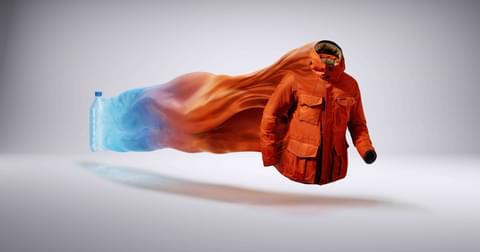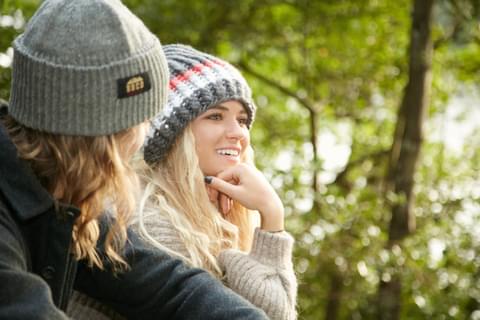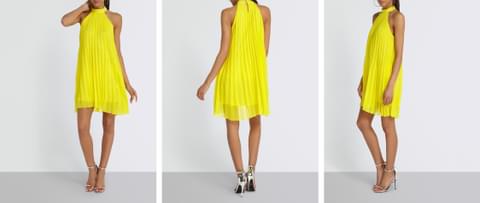An Expert Guide To Model Photography For Ecommerce Fashion Brands
Model photography for the purposes of ecommerce requires a keen eye for detail, strong creativity, and excellent communication skills.
There can be a lot of work involved to ensure your shoot runs smoothly, your images are captured, and you achieve the outcomes that you envision. When people are the ones being photographed there are more variables to consider, making model photography a greater challenge than invisible mannequin or flat lay.
However, the benefits of modelled fashion for ecommerce bring a huge amount of value, allowing brands to show personality and tell stories which helps build a connection with their customers.
Choosing Your Model
Selecting the right model is one of the most important parts of your shoot. Consider the look, age, and experience that you would prefer before making any decisions as these must fit your brand and the concept of the shoot. More complex shoots will require experienced models, so consider how challenging the poses will be and whether there is any acting required as this will be more demanding for the model.
You should also think about how your model represents your core customer base, and be aware of diversity in your choice as this will impact how your brand may be perceived.
There are a number of options you can use to source models:
- Social Media
- Many models will promote themselves on platforms such as Instagram. This allows you to view their portfolios easily. You can search using locations and hashtags.
- Modelling Websites And Databases
- There are plenty of listing sites that contain models’ portfolios. Try sites such as Model Mayhem, Net-Model, and Model Management.
- Local Community
- If your shoot is simple, think about who you know. Friends and family may be able to help out which will keep the costs down.
- Modelling Agencies
- If you want an experienced model then your best option is to reach out to a model agency. If you’re using a professional photography studio like us, it’s likely that they will have trusted contacts as well.
Remember to do your research if you’re not using a model or agency you have worked with before. Here are some things you should be looking for in their portfolio:
A Variety Of Images
Look for a diverse range of images that show different styles, poses, angles and locations. You need to be sure that the model can replicate the vision for your brand, so try to find evidence of this in their portfolio.
Different Types Of Modelling
Modelling can be a broad term. Think about what you need from your shoot and what type of modelling this is, i.e. lifestyle, fashion, commercial. Make sure their portfolio shows they can deliver what you need.
What To Watch Out For When Researching Models
- Low-Quality Photos
- This may seem obvious, but don’t let a model’s looks sway your decision instead of their portfolio, abilities and experience.
- High Upfront Fees
- There are plenty of high-quality models that will deliver results without being excessively expensive. If you see high fees, shop around.
- Terms And Licence Requirements
- Be sure to enquire about any usage terms such as the length of time you plan to use the images for, and where you plan to use them i.e. adverts, social media, website. This will likely affect the price of the model. For child models, you will be likely to need specific licences from your local authority.
- Pressure To Sign Quickly
- Be wary if you’re being put under pressure to sign the model quickly without having the time to review portfolios, requirements, and terms of service.
- Unclear Contract
- Take the time to read any contracts in place, being sure to question anything you don’t understand and request alterations if you are not comfortable with the terms of use.
- Negative Reviews
- Today’s digital world means that reviews are easy to find. The odd negative review shouldn’t raise an alarm but look out for any repeat patterns.
Getting The Lighting Right
Lighting is as important when working with models as any other form of photography. With the added complexity of a model involved, it’s important not to forget about the basics.
Additionally, the type of lighting you choose can dramatically change the mood and feel of your photos helping to align with the creative direction of your brand. Here are some ideas that you could use in your next shoot:
Split Lighting
This technique casts half the model’s face in shadow whilst illuminating the other half – perfect for a dramatic effect.

Loop And Rembrandt Lighting
These styles cast a shadow around the nose and are a popular technique in portrait photography but can also be used in fashion. It’s a very versatile form of lighting that can be used for several styles.

Butterfly Lighting
Here the lighting is central and casts a shadow directly under the model’s nose. It’s often used for glamour shots and is also known as Paramount Lighting.

Beauty Box
This entails large setups that disperse a lot of light onto the subject to produce a soft light look with few shadows. This is one of the more popular styles of lighting.

Hard Light
This casts strong shadows using a directional light, such as a spotlight, a flash, or the sun. It can be used for an atmospheric look and creates a daytime or evening setting.

Help Your Model To Be At Their Best
Here’s our top tips for getting the best out of your chosen model.
Breaking The Ice
You should aim to create a friendly and relaxed atmosphere during the photo shoot. Building rapport with the model ahead of time can make them feel comfortable and at ease. Using models that you’ve worked with before helps, but if this isn’t possible, a meeting or call ahead of the shoot can be just as good.

Be Aware Of Your Model’s Experience Level
Experienced models will be quicker to understand a brief, find the best poses, and work with the photographer more effectively. Less experienced models will need frequent direction, which can hinder the photographer from focussing on the composition of the image.
Set A Clear Direction Before The Shoot
Making decisions ahead of time will help you and the model have a greater understanding of what is required for the shoot. On the day, keep the lines of communication open between yourself and your model. This helps establish trust and ensures that you are both working towards the same goal.
Consider Hair And Makeup
You’ll need to make sure that your model’s hair and make up complements the style you are hoping to achieve. Often a professional is the best option if you have the budget. Your hair and makeup artist may need up to an hour to prepare the models for the camera. Their expertise ensures that under studio lighting your models will look perfect, meeting your brief and reflecting your brand style.
Don’t Stick With One Single Pose
It can help to create a shot list before the shoot with ideas of poses that best show off the garments or that fit with the brand. This is important if your clothing has a specific use such as athletic apparel. However, you should still allow creativity to spark during the shoot by experimenting with innovative ideas or making adjustments based on how the model interacts with their surroundings. Try to make time in your schedule for new additions.



Give Your Model A Character To Play
If you have a clear vision for your shoot, communicating this to your model by giving them a character to play can help bring out unique expressions and poses. Think villains for something dark and moody, adventurer for an outdoor brand, or quirky for a fun shoot. It’s all about communicating your vision to those involved, and this technique might make it easier.

Use Natural Poses
Try to avoid stiff and awkward poses that can be off putting and distract from the purpose of the image. Use natural poses that the model is comfortable with and don’t force anything that could be jarring.
Fashion photography is all about capturing the perfect shot of a model that shows off your clothing brand. It’s important to consider the poses that will best suit the style you’re aiming for, here’s a few more ideas:
The Classic Model Pose
The model puts one foot in front of the other, slightly bending the front leg, and placing one or two hands on their hips. This pose is relatively simple, but effective for an impactful ecommerce image.

The Sassy Hip Pop
Have your model shift their weight onto one leg, popping their hip out to the side. This one is good for adding personality into women's fashion shoots without being too difficult to achieve.

The Lean
On a wall, a prop or anything, this one is great for lifestyle photography. It's a pose that sets a casual tone and will feel natural which can be great for inexperienced models. Just remember to get the lighting right as shadows may be prominent on the walls.

The Over-the-Shoulder Glance
With the model’s back to the camera, they look over their shoulder. This is perfect for showing the back of a garment whilst keeping personality in the shot. Play around with the angle to see what works best for your garments.

The Casual Sitting Pose
Sitting on the edge of a chair or bench, the model has one knee bent and the other leg extended. This gives your images a relaxed feel and works well for informal garments and backdrops. Remember to consider the style of the chair to make sure the aesthetic works with the garments.

Hands Near Neck, Face Or Hair
Depending on how you do this, you can show your model in a range of moods as our hands can depict anything from sadness to joy. It's an easy pose to quickly change in the moment to see what works for your shoot.

Create Movement
Add movement to the poses to create dynamic and engaging images. Stick to simple movements, and show how a garment falls during gentle walking, turning, and arm sways. Above all styles, this is most important for active wear. Encourage your model to be highly expressive and copy poses from activities the clothes are made for such as running, stretching, and yoga.

Model The Details
Have your model demonstrate the features of your garments to help point out unique selling points. This could be zips, buttons, pockets, hoods or any other feature.



Try to prepare your poses in advance to plan your shoot, and speak to your model – they may suggest some ideas too!
How To Get The Most Out Of Your Model
It's important to help your model perform at their best regardless of their experience level. Directing models during a photo shoot can be a challenging task especially if you’re also taking the photos. With the right approach however, you can make the process smoother and more effective. Here's our advice on getting the most out of your model on the day.
Check Your Demeanor
Your mood on the day can affect how a shoot can go, particularly if models are involved and you want to get the best out of them. This can get difficult if there is time pressure involved in your shoot, however you must aim to remain calm when directing.
Take An Interest In Your Model
If you can be in tune with how your model is feeling, you can adapt on the day of the shoot. You don’t have to get too personal, but creating rapport by asking questions that aren’t shoot related at the start of the day will build trust for both parties.
Be Yourself
Don’t act how you think a director should act. Speak in your natural way and become comfortable with your role – your model will feed off this, and any doubts could interfere with the end results.
Prepare In Advance
The photographer should always be the first to arrive on set. This is to ensure that everything can be set up to maximise the model’s time – remember time is money! This will also help you to focus on directing your model, which is difficult when trying to set up on the fly.

Consider Demonstrating Poses
Try to communicate with your model by showing them how you would like them to pose. It can be frustrating when someone doesn’t follow explanations, so demonstrate the more complex poses. Then when you are using verbal cues to direct your model, be as specific as possible. Clarity in your direction will only benefit your shoot.
Provide Constructive Feedback
You will need to consider how you correct your model when they are struggling to replicate your ideas. This can be tricky, if you're too harsh you could damage your relationship with the model, but if you're too cautious you won't get the photos you wanted. Emotional intelligence, and understanding of Radical Candor can help in such circumstances.

Use Music to Help You Out
The use of music will depend on the people involved. Speak with your models and any other members of the team to make sure you’re all on the same page. Be aware that music may be distracting or could hinder your efforts to communicate with your model, but can break the ice, inject some energy, and set a mood for the project.
We're Here To Help
If you are booking a modelled fashion photography shoot with a photography studio or trying it yourself, we hope this guide has helped.
Prodoto shoot model photography for fashion brands of all sizes, including some of the biggest names in the game. In fact, we’ve delivered shoots for over 1,200 clients! We're happy to have a conversation about how we can help you.
Take advantage of our knowledge and experience of delivering quality photography audiences love, capturing those seasonal styles and trends. Take a look at some of our fashion photography work below.
Find out how we can bring your fashion products to life with exceptional photography or get in touch to speak to a member of our helpful team!






